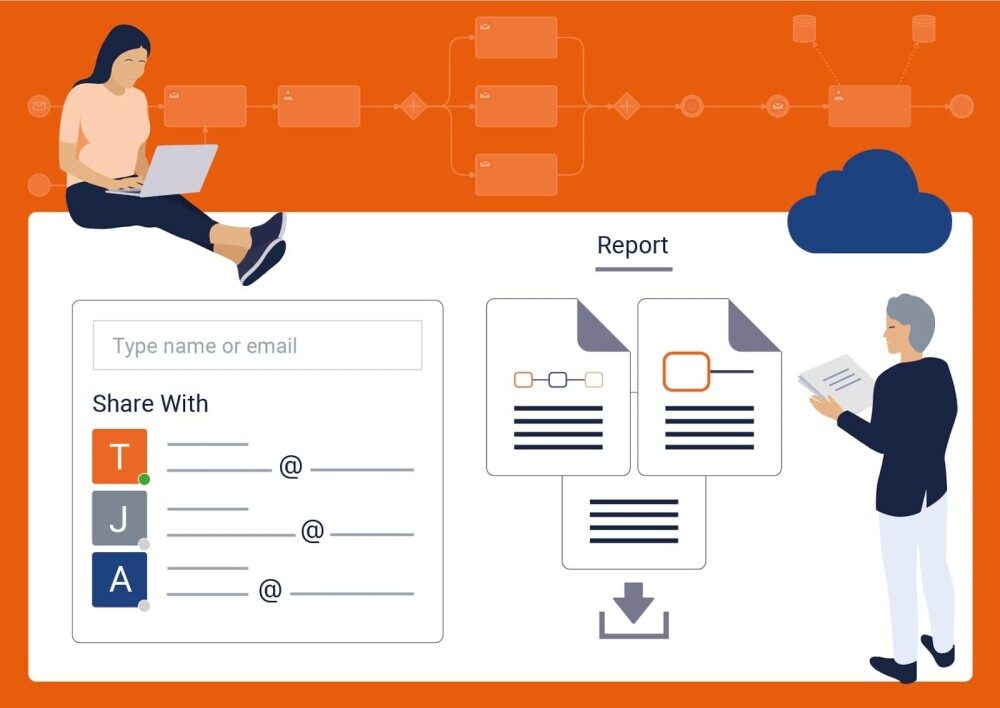When you look at the types of solutions that pertain to business process management, or BPM, you might find that there are many to choose from, including the traditional route of bringing on a BPM professional whose own work could consist of pen-and-paper planning and resolution. However, businesses are increasingly discovering that managing business processes is often easier, more straightforward, and more desirable when they are managed not by hand, but by a software that aids in the design, the execution, and even in the decision making process itself.
It’s not hard to see some of the benefits already of doing so, but even more than using software, being able to procure a cloud-based program to help manage business processes creates even more of a boon to businesses in this day and age. Below are the seven concrete examples of that benefit to anyone taking on a cloud BPM software!
Design Collaboration
From the very beginning, cloud-based programs insinuate that collaboration, that universality of access, is possible in ways not always seen before. This is true of BPM, as well, since you can bring on a team of people to look at, build, and modify the business process as it begins to form. Even long after the initial forming, you can take the same idea of universal remote collaboration and bring it into the optimization stage. Every business process will need improvement, and if one leader of your digital workflow team understands and sees the opportunity, they should be able to fix it themselves, rather than waiting for a designated person to do so. In the case that you do have a designated person for such fixes, even the ability for other users to have this visibility is key to improvement in performance as well as other needs.
Workflow Orchestration
After your business process has been designed in a cloud-based BPM, it’s easy to get distracted by the many cues and sudden intricacies that the business process might have. A BPM cloud tool is equipped to handle these, though — rather than forcing you into that space of having to time things yourself and be the active intermediary between each process activity, the software in place can do so for you with workflow orchestration. This means the tool will signal each activity for necessary starts and ends, initiate information transfers, and more all from one central connection hub between all the existing activities — leaving you with more time and less human error in the execution of each task.
Simplified Troubleshooting
Cloud-based BPM makes it all the easier to find out what a problem is in the first place, with much of the program using automated signals to indicate red flag activity within a workflow. Even more than that, though, there can be indications on a BPM cloud tool that tell you what kind of issues you’re facing — or even how to fix what’s wrong. This is a far cry from the traditional way of handling troubleshooting, where you’d not only have to investigate indicated problems by first finding the source, but by also testing to find out what exactly was wrong.
Monitoring and Improvement
The visibility of a business process — especially one that’s digital — is essential to creating a well-oiled machine. By being able to monitor performance of all aspects of a process behind one pane of glass, cloud BPM software makes this visibility greater than ever. It also makes it easier for anyone to find and address the indicators pointing to needed improvement. Whatever that looks like may change from situation to situation, but the constant is that you’re able to see measurements of performance and have real-time visibility of your fixes — making continuous improvement more of a reality.
On-Demand Deployment
Anyone familiar with cloud-based tools understands what this means. Without having to utilize local resources, much of your changes and containers in a workflow can be brought to effect on demand, sometimes with just a click depending on what process you’ve put in place. Additionally, you’ll often have the ability to deploy these without jumping through several hoops. By allowing your business process the ability to deploy so quickly and easily, in addition to the visibility you have in monitoring your processes, it’s now possible to deploy from anywhere, and to do away with much of the checklist and preemptive work that goes into task deployment.
Horizontally Scalable Processes
Thanks to not needing local resources, horizontal scaling in a cloud BPM tool is very uncomplicated and achievable, with the BPM software primed to take on more virtual machines as needed in any case, wherever in the process you feel you need to place them. Any time you help your business grow by doing this, cloud-based BPM makes it possible and more intuitive.
Accessibility
BPM was once the domain of professionals whose training had much to do with the calculation of process metrics, the intimate knowledge and theory of design, and the well-meaning idea that one person or department would be in charge of these features: measuring performance, finding bottlenecks, and so on. Only with the advent of BPM software has it become more possible (and made more sense) to eliminate the exclusivity of such a role and to instead allow professionals to develop more active, accessible roles in BPM activity. With cloud BPM, this is even more true, with remote professionals having the ability to handle the needs of a business process from wherever they are, instead of having to be on-site somewhere.
